
- Home
- India
- World
- Premium
- THE FEDERAL SPECIAL
- Analysis
- States
- Perspective
- Videos
- Sports
- Education
- Entertainment
- Elections
- Features
- Health
- Business
- Series
- Bishnoi's Men
- NEET TANGLE
- Economy Series
- Earth Day
- Kashmir’s Frozen Turbulence
- India@75
- The legend of Ramjanmabhoomi
- Liberalisation@30
- How to tame a dragon
- Celebrating biodiversity
- Farm Matters
- 50 days of solitude
- Bringing Migrants Home
- Budget 2020
- Jharkhand Votes
- The Federal Investigates
- The Federal Impact
- Vanishing Sand
- Gandhi @ 150
- Andhra Today
- Field report
- Operation Gulmarg
- Pandemic @1 Mn in India
- The Federal Year-End
- The Zero Year
- Science
- Brand studio
- Newsletter
- Elections 2024
- Events
- Home
- IndiaIndia
- World
- Analysis
- StatesStates
- PerspectivePerspective
- VideosVideos
- Sports
- Education
- Entertainment
- ElectionsElections
- Features
- Health
- BusinessBusiness
- Premium
- Loading...
Premium - Events
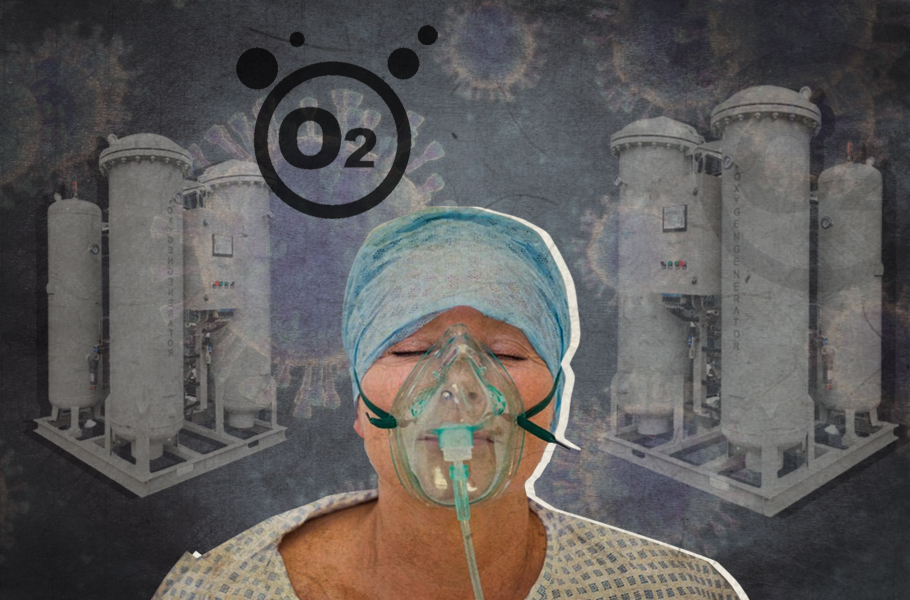
Oxygen: The gasping reality behind the crisis
To meet the urgent demand for medical-grade oxygen, 28 captive plants in refinery and steel industries have been diverted to produce about 1,500 MT medical grade oxygen daily.

In an irony of sorts, the day when NASA turned its MOXIE aboard MARS Perseverance lander to convert Martian atmospheric carbon dioxide into oxygen, in India, television screens were filled with appalling scenes of COVID patients scrambling for medical oxygen. In the last few weeks, the spurt of cases has caused the medical oxygen supply grid to go haywire, putting the lives of many on...
In an irony of sorts, the day when NASA turned its MOXIE aboard MARS Perseverance lander to convert Martian atmospheric carbon dioxide into oxygen, in India, television screens were filled with appalling scenes of COVID patients scrambling for medical oxygen.
In the last few weeks, the spurt of cases has caused the medical oxygen supply grid to go haywire, putting the lives of many on the brink.
Oxygen
In the atmosphere, oxygen is mainly present as an oxygen molecule, containing two loosely interconnected atoms of oxygen secured by an electron bond. Due to this weak bond, the oxygen molecule is one of the highly reactive elements. It reacts readily with substance like iron to form rust, and this process of oxygenation helps in combustion.
Oxygen from Air is needed to be mixed with petrol or diesel in the car engine to combust. The glucose (C6H12O6) in our body uses a process akin to the ‘burning’, using up oxygen, and releasing energy to our tissues.
From the ticking of the brain, thumping of the heart to twitching of mussels in our body, the energy needed is provided by this process of oxygenation. Bereft of oxygen, organs fail, and cells die.
Discovery of oxygen
Joseph Priestley, an English chemist, was the first to isolate oxygen from the air. Writing about it in 1775, in the Philosophical Transactions of the Royal Society, he said, “This air is of exalted nature. A candle burned in this air with an amazing strength of flame; and a bit of red hot wood crackled and burned with a prodigious rapidity, exhibiting an appearance something like that of iron glowing with a white heat, and throwing sparks in all directions. But to complete the proof of the superior quality of this air, I introduced a mouse into it; and in a quantity in which, had it been common air, it would have died in about a quarter of an hour; it lived at two different times, a whole hour, and was taken out quite vigorous.”
From the time of its discovery, its role in sustaining animal life was well-known. However, the French chemist Antoine Lavoisier in 1777 mistakenly held that acidity, that is, the sourness of the acidic substances, were caused by the presence of oxygen in the compound and named this gas ‘oxy’ (sour), ‘gen’ (born/maker), or ‘oxygen’ would mean it is an acid-generating substance.
Medical use
Right from its discovery, its role in sustaining animal, including human life, was well known from the experiments of Priestly. Hence from the 1800s, oxygen was put to medical use. In early times oxygen was seen to help people with respiratory arrest and those feeling fatigued.
Today medical oxygen is used to treat various conditions such as respiratory arrest, cardiac arrest, shock, carbon monoxide poisoning, and severe haemorrhaging. Medical oxygen is a critical element in the healing of severe pneumonia, malaria, sepsis and meningitis.
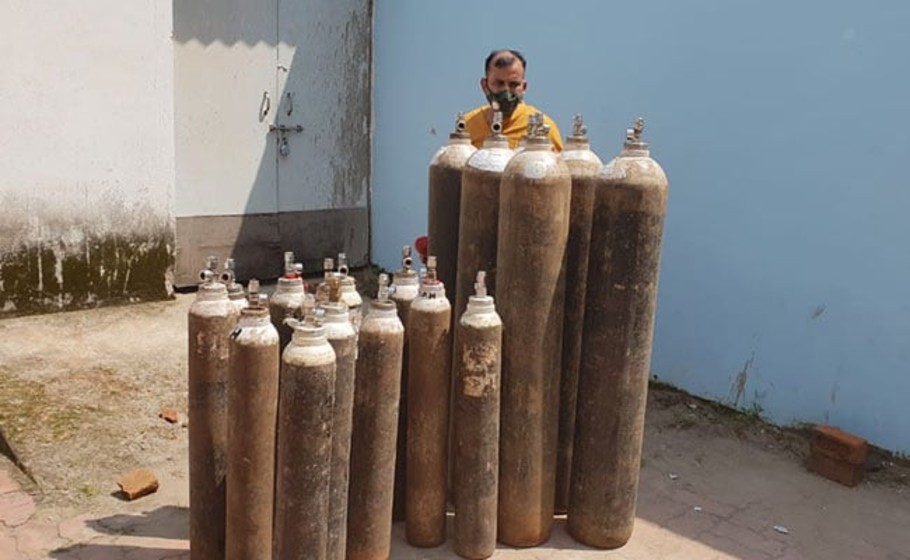
Medical oxygen
In various countries, the medical oxygen is a drug, and one needs a medical prescription to access it. Oxygen with 99-100% purity is the first requirement for it to be used as medical oxygen.
The levels of carbon monoxide must be below 5 ppm and that of carbon dioxide less than 300 ppm. The gas must also be free of halogens, plastics and water vapour.
In the presence of moisture, germs can grow, threatening the patients. However, before the dry oxygen is given to the patients, it is passed through a humidifier; otherwise, the lungs will get affected.
How the lungs take in oxygen
The lungs are studded with numerous air sacs called Alveoli. There are, in fact, 480 million alveoli located at the end of bronchial tubes. All of these alveoli put together have about 100 square meters of surface area—the tiny capillaries carrying blood, criss-crossing the alveoli walls.
Like a magnet attracts an iron pin, the haemoglobin in the blood can attract the oxygen atom. As the binding energy between two oxygen in an O2 molecule is low, this attraction can break a sufficient number of molecules into two oxygen atoms. The atoms of oxygen then travel through the capillary wall and are absorbed by the haemoglobin. Due to the partial pressure difference, the CO2 in the blood moves out of the blood into the lungs.
Oxygen-rich blood circulates and takes it to different parts of the body. The brain is a big guzzler of oxygen. About 20% of the oxygen we breathe is consumed by the brain.
However, our tissues can store oxygen for a short duration. The brain lacks such local storage and suffers the immediate adverse effect. Hence in the absence of oxygen, the brain is immediately affected, and death may result.
How much oxygen we consume in a day
In each breath, we uptake from 5-8 litres of air per minute. Of this, about 20%, that is, about one litre, is oxygen. Although there is a large surface area for the gas exchange in the lungs, the process is sluggish.
Hence only about 0.3 litres of oxygen is exchanged into our blood per minute. In other words, although 20% of the air we intake is rich in oxygen, the exhaled air still has 15%, and only one-fourth of the oxygen is absorbed by our blood. In a day, we consume about 550 litres of oxygen.

An ICU patient connected to a ventilator will require about 24 litres of medical oxygen per minute. If the same patient is not on a ventilator, he/she would need about one litre of medical oxygen per minute.
COVID and oxygen
Medical oxygen is vital in treating the severe state of COVID. Once the novel coronavirus enters our respiratory tract, they go on to infect the lungs. The virus enters the epithelial cells of the lungs initially. Once inside, they use the human cellular mechanism to make copies of its RNA and adequate production of four structural proteins. Using these, more viruses are created inside our infected cells. One estimate says that a virus-infected cell would produce as many as 100 copies of the virus in ten hours.
By this time, our immune response would detect that something is amiss and target the infected cells. The infected cells would be destroyed, and the debris of these fall into the lungs and clog the alveoli. As more and more alveoli are blocked, we experience a fall in oxygen levels. Pneumonia sets in. We become breathless.
When we reach that state, the only way to treat the disease is by providing medical oxygen. If the lungs are still working, then oxygen can be administered without a ventilator.
If the situation becomes severe, then the patients have to be connected with ventilators. If we remain in a state of lack of oxygen, multiple organs, including the heart, may fail, leading to death.
How oxygen is artificially produced
Broadly two significant technologies are used to produce oxygen. The first and the oldest method is the air separation method (ASU). The more recent technology is the Pressure Swing Adsorption (PSA) process.
When you taduka and cook vegetables, we can see that oil and water are mixed and put to boil. However, as the boiling point of water is 100°C, whereas the boiling point of cooking oil is usually more than 300°C, the water evaporates, but oil-coated vegetables remain.
In like manner, in cryogenic air separator units, atmospheric air is first filtered for dust and other pollutants. Then it is cooled to about −196°C. At standard pressure, at this temperature, air will become a liquid.
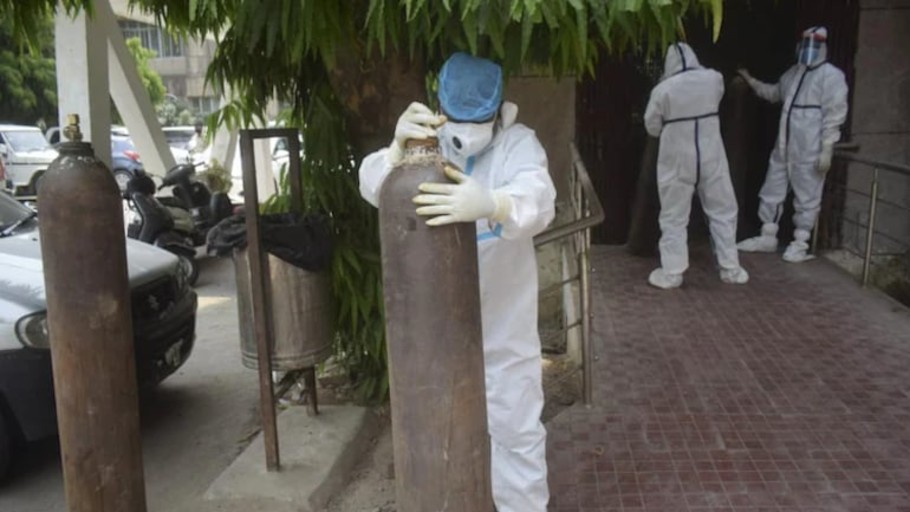
If the liquid air is slowly allowed to increase the temperature, then when the temperature reaches −195.8°C, the boiling point of nitrogen, only the nitrogen in the liquid air would evaporate. The nitrogen gas could then be captured and stored.
Likewise, of the remaining fraction, CO2 can be obtained if one raises the temperature to about −78.46°C, the boiling point of CO2.
At −183°C, the boiling point of oxygen, oxygen molecules will bubble out from the remaining fraction. This is the most widely used technology but is highly energy-intensive.
The Pressure Swing Adsorption (PSA) process uses another property of gases. If CO2 gas is mixed with water under high pressure, we know that it can dissolve and produce fizzy soda.
Likewise, when we pass air over substances such as zeolite under intense pressure, nitrogen is selectively adsorbed by the zeolite sponge. The remaining air is rich in oxygen.
If we repeat this process many a time, we can get purer oxygen suitable for medical use. From the zeolite sponge, we can also obtain nitrogen which has many industrial uses.
Why artificial oxygen is produced?
In India, about 7,127 metric ton of oxygen is produced by various plants for different uses. A substantial part of this is produced by cryogenic air separator units.
The primary purpose of this oxygen production is not medical use but for industrial needs, including combustion, oxidation, cutting and chemical reactions. For example, for every ton of steel production, one needs about two tons of oxygen.
Further, oxygen is an essential component in the petrolatum refineries, production of ampules, vials and pharmaceutical industry. Additionally, it is also used in food processing, wastewater treatment and water purification. Many of these industries, such as steel plants, and refineries have in-house oxygen generating plants to meet their requirements.
Most of the Pressure Swing Adsorption units are housed in big hospitals with enormous medical oxygen demands. Although the technology was first developed in the 1970s, only in the last two decades, these are widely used.
This technology is also often used by the industries producing dedicated medical grade oxygen. The technology is viable for miniaturisation. Home units are also available to provide medical oxygen to patients suffering from diseases that require long term oxygen supply. Further, as the production location is often near consumption, these units don’t suffer logistics troubles.
Supply and demand
Before the affliction of COVID in India, we used about 700 MT of medical oxygen per day. Even then, at some places, preventable deaths occurred due to want of medical oxygen, yet there was no scarcity.
When the first wave of COVID hit, the oxygen demand rose to 2,800 MT per day. At the onset of the second wave, in early April 2021, the consumption went up to 3,842 MT per day. However, in the last few days, the demand has reached around 6,600 MT, and experts estimate that it can go as high as 8,000 MT shortly.
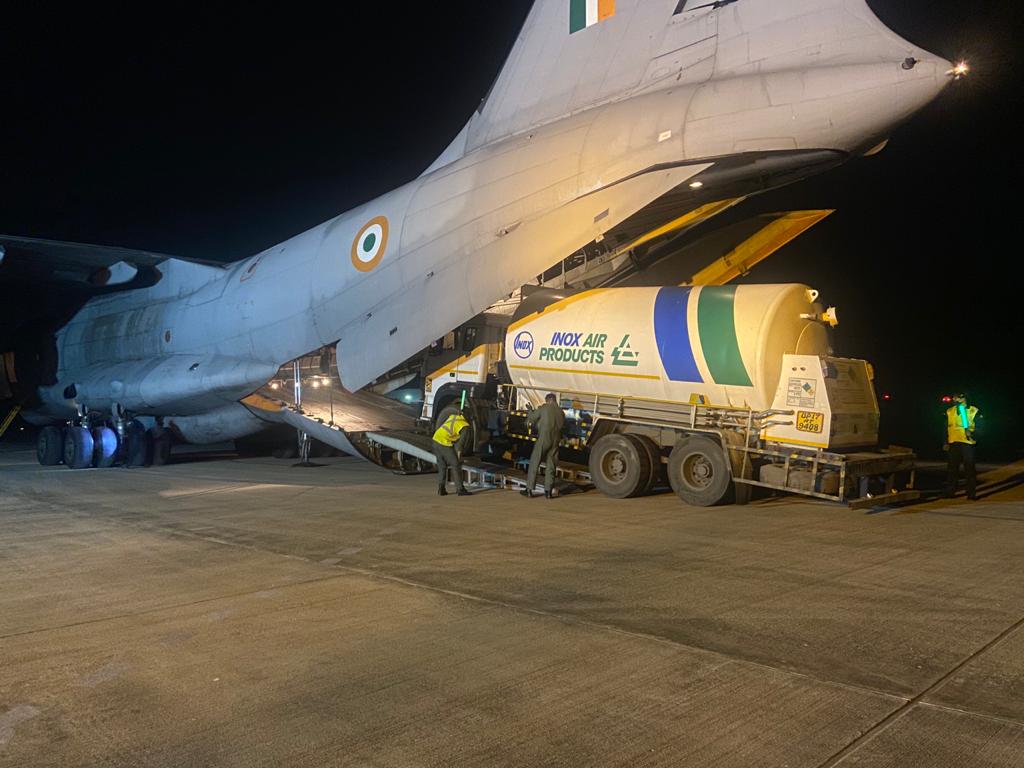
Realising the need to beef up the medical oxygen production, during April 2020, the central government proposed establishing on-site PSA units at 162 medical facilities. The state governments suggested that this number be augmented with additional 100 units to boost public health infrastructure.
Each unit cost around ₹1.3 crores. Of these, only 33 have been installed—five in MP, four in Chandigarh, Uttarakhand and Gujarat, three in Himachal, two in Bihar, Karnataka, and Telangana, one in Andhra Pradesh, Chhattisgarh, Delhi, Haryana, Kerala, Maharashtra, Puducherry, Punjab and UP.
India has an installed capacity for the daily production of 7,287 MT oxygen. Until now, only about 15%-20% were towards medical grade oxygen. Essential industries need oxygen such as steel, petroleum, pharma and so on use about 2,000 MT daily. During the beginning of April, India had a stock of about 50,000 MT oxygen, not all of them a medical grade.
To meet the urgent demand for medical-grade oxygen, 28 captive plants in refinery and steel industries have been diverted to produce about 1,500 MT medical grade oxygen daily. Further, the government also has plans to import about 50,000 MT of medical grade oxygen.
Since the onset of the pandemic, from March 2020, the distribution and allocation of medical grade oxygen are controlled by a central government empowered group, EG II, headed by the secretary in the department to promote industry and internal trade.
Mismatch
The highest consumption of medical oxygen during March 2021 was by Maharashtra, Gujarat, Madhya Pradesh, Uttar Pradesh, Karnataka, Tamil Nadu, Delhi, followed by Chhattisgarh, Punjab, Rajasthan. However, 80% of dedicated oxygen production plants are at Maharashtra, Gujarat, Jharkhand, Odisha, Tamil Nadu, Karnataka, Kerala and West Bengal. The places that need oxygen dearly do not have facilities.
The logistics of transporting the medical oxygen is also playing a part in exacerbating the crisis. Once the medical oxygen is produced, it is either stored in liquid form in cryogenic tanks or in gas form in cylinders. Industrial cylinders are not permitted for use to store and supply medical grade oxygen.
Small hospitals favour cylinders for bedside medical oxygen dispensing; however, big hospitals have tubes reaching beds. The oxygen is stored in a huge tank, and it is supplied to the bedside through pipes reaching out to beds. Nevertheless, with the increase in COVID cases, as the number of people needing oxygen has increased, even big hospitals resort to using cylinders, creating a scarcity.
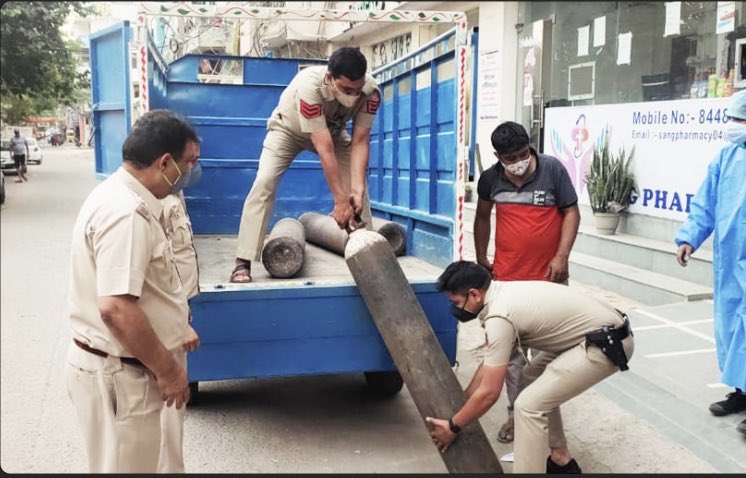
Medical and industrial grade oxygen is an explosive substance and is hence covered by rules related to handling hazardous substances. Trucks carrying them have a speed limit and are usually operated only at night to avoid accidents.
States out of the red
With 12 steel plants, Odisha has around 70 industries that can be tweaked to produce medical grade oxygen. Likewise, the steel and refineries in Andhra Pradesh and Jharkhand are being retooled to produce medical grade oxygen. Tamil Nadu and Kerala have medical oxygen self-sufficiency.
Predicting the worst Kerala had with foresight undertaken to ramp up medical oxygen production since March 2020. Today it uses about 35 MT for COVID and 45 MT for non-COVID use. However, they can produce 199 MT of medical oxygen. Likewise, in TN, the production capacity is 400 MT, and the current consumption is around 240 MT.
